Discover the beauty of watercolour painting with free PDF resources, including guides like “Watercolour for Beginners” and “Creative Watercolor Techniques,” perfect for mastering this expressive art form.
What is Watercolour Painting?
Watercolour painting is a translucent art medium where pigments, suspended in a water-based solution, are applied to surfaces like paper or canvas. Known for its fluidity and unpredictability, it creates delicate, layered effects. The technique allows for soft blends and vivid contrasts, making it ideal for capturing light and mood. Watercolours can be used on various surfaces, including grease-free boards and acrylic paintings, offering versatility for artists. This medium is celebrated for its unique ability to balance spontaneity and control, producing distinctive, ethereal results in both traditional and modern art forms.
History and Evolution of Watercolour Art
Watercolour painting traces its roots to ancient civilisations, with evidence of its use in Egyptian and Chinese art. Initially used for illuminated manuscripts, it evolved in Europe during the Renaissance as a sketching tool. By the 18th century, watercolours gained popularity as a medium for landscape and botanical art. The 19th century saw the rise of watercolour societies, formalising its artistic status. Today, watercolour art thrives globally, with modern artists experimenting with techniques and surfaces, ensuring its enduring relevance in contemporary art, as highlighted in resources like The Watercolour Artists Handbook and works by leading artists.
Why Choose Watercolour Painting?
Watercolour painting offers a unique combination of translucency and fluidity, allowing for delicate, ethereal effects. It is ideal for capturing soft, natural light and subtle colour transitions. This medium encourages spontaneity and creativity, as water and pigment blend unpredictably. Watercolour is versatile, suitable for landscapes, portraits, and abstracts. It is also a great way to practice patience and precision, fostering a meditative process. Whether you’re a beginner or an experienced artist, watercolour painting provides endless opportunities for artistic expression and personal growth, as explored in resources like The Joy of Watercolour.
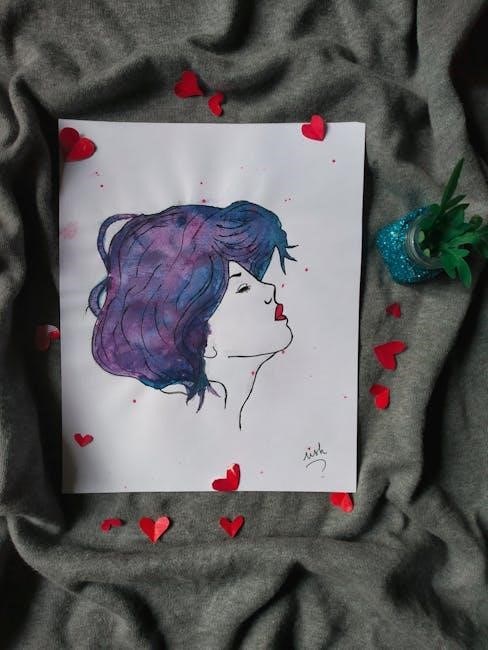
Essential Materials for Watercolour Painting
Watercolour painting requires high-quality paints, brushes, and paper. A sturdy palette, water containers, and optional tools like masking fluid or tape are also key for success.
Watercolour Paints and Pigments
Watercolour paints are made from pigments suspended in a water-based solution with a binder, typically gum arabic. High-quality paints use light-fast pigments to resist fading. Professional-grade paints have higher pigment loads for vibrant colours, while student-grade options may include fillers. Natural pigments, like earth oxides, and synthetic ones, like phthalo blues, offer diverse colour palettes. Understanding pigment properties ensures better colour mixing and durability. Always choose paints that align with your artistic goals and budget for optimal results in your watercolour journey.
Brushes: Types and Uses
Watercolour brushes come in various types, each suited for specific techniques. Round brushes are ideal for fine details and creating sharp lines, while flat brushes excel at broad washes and covering large areas. Mop brushes, with their soft, absorbent fibres, are perfect for blending and creating soft, gradient backgrounds. Natural hair brushes, like sable, hold more water and pigment, offering superior control. Synthetic brushes are more affordable and durable, making them a great alternative for beginners. Choosing the right brush ensures precision and versatility in your watercolour work.
Watercolour Paper: Quality and Texture
High-quality watercolour paper is essential for achieving optimal results. It is typically made from cotton or linen, ensuring durability and resistance to buckling. Papers are categorized by weight, with 140lb (300gsm) being the most common for watercolour work. Texture options include hot press (smooth), cold press (textured), and rough (heavily textured), each suited for different techniques. Hot press is ideal for fine details, while cold press and rough papers enhance expressive brushstrokes. Choosing the right paper texture and weight ensures vibrant, long-lasting watercolour artwork.
Additional Tools and Accessories
Beyond paints and brushes, essential tools enhance your watercolour workflow. A sturdy palette with built-in wells keeps colours organized, while a spray bottle maintains paper moisture. Masking fluid and masking tape protect areas from unwanted pigment. A sharp utility knife or scissors trim paper to size. Blotting paper absorbs excess water, and a mixing tray aids in colour blending. Optional tools like sponges or texture stamps add unique effects. These accessories help create a well-rounded workspace for watercolour painting, ensuring efficiency and precision in your artistic process.
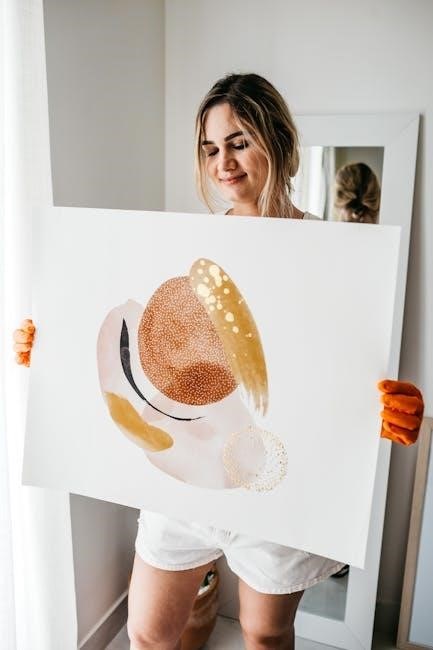
Basic Techniques in Watercolour Painting
Mastering foundational methods like washes, blending, and drybrushing is key. These techniques help achieve transparency, texture, and depth, forming the backbone of watercolour artistry. Practice is essential.
Washes: Creating Layers and Transparencies
Washes are a fundamental technique in watercolour painting, used to create soft, layered, and transparent effects. A wash involves applying diluted paint evenly across the paper. Flat washes cover large areas uniformly, while graded washes transition from dark to light. The key is to balance pigment and water for desired opacity. Start with light layers, gradually building depth. Practice controlling the wash to avoid muddiness. This technique is perfect for capturing skies, backgrounds, and subtle shifts in tone. Mastery of washes enhances atmosphere and luminosity in your work.
Blending and Mixing Colours
Blending and mixing colours are crucial for achieving harmony and balance in watercolour painting. Start by understanding primary and secondary colours, then experiment with warm and cool hues. Mix pigments on a palette or create soft transitions by blending wet colours on paper. The ratio of pigment to water determines transparency and vibrancy. Practice creating a colour wheel to explore combinations. Testing colour mixes on scrap paper helps predict results. This skill enhances your ability to capture subtle shifts in tone and mood, essential for realistic and expressive compositions.
Drybrush and Wet-on-Wet Techniques
Drybrush and wet-on-wet techniques add texture and spontaneity to watercolour painting. Drybrush involves dragging a nearly dry brush across paper to create rough, organic textures, ideal for details like grass or tree bark. Wet-on-wet, by contrast, applies wet pigment to damp paper, blending colours softly for fluid backgrounds or skies. These methods enhance visual interest and depth, allowing artists to achieve dynamic, expressive effects that elevate their work beyond basic washes. Practice both to expand your creative possibilities and capture intricate details with ease.
Sketching and Planning Your Composition
Sketching and planning are essential steps in watercolour painting, ensuring balance and harmony in your work. Start with light pencil strokes to outline your composition, focusing on proportions and placement. Use thumbnail sketches to visualize the layout and experiment with different arrangements. This stage helps establish the flow of the painting and prevents errors. Refine your sketch carefully, as it serves as the foundation for your artwork. Planning allows you to anticipate challenges and achieve a cohesive final piece, making the painting process more efficient and enjoyable.
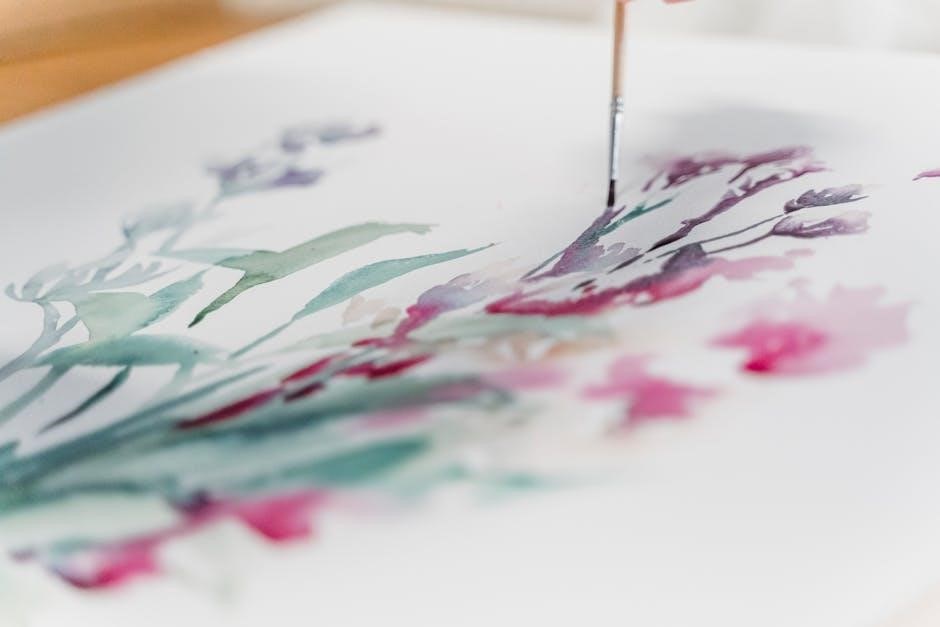
Free Watercolour Painting PDF Resources
Discover a wealth of free watercolour painting PDFs online, offering guides for beginners and advanced artists. Explore tutorials, techniques, and inspirations to enhance your skills.
Popular eBooks for Beginners
Popular watercolour painting eBooks for beginners are perfect for those new to the medium. These free resources offer step-by-step guides and introductions to essential techniques, helping you master the basics. They cover material selection, colour mixing, and practical exercises to build confidence. With progressive learning paths, these eBooks ensure a smooth transition from fundamental skills to more compositions. Filled with beautiful examples and tips, they provide inspiration and guidance, helping you unlock your creative potential in watercolour painting.
Advanced Techniques and Guides
Advanced watercolour painting PDF guides cater to experienced artists seeking to refine their skills. These resources delve into complex techniques like layering, glazing, and texture manipulation. They often focus on mastering challenging subjects such as dynamic skies, water reflections, and intricate details. Packed with expert tips and demonstrations, these guides help artists explore new creative possibilities and achieve professional-level results. Many include step-by-step examples and before-and-after comparisons, making them invaluable for those looking to push their watercolour art to the next level;
Step-by-Step Tutorials and Exercises
Watercolour painting PDFs often include detailed, step-by-step tutorials designed to guide artists through specific techniques and projects. These resources provide clear instructions, visual demonstrations, and exercises to practice essential skills like washes, colour mixing, and brushwork. Many feature exercises tailored for beginners, such as painting simple subjects like fruit or flowers, to build confidence and technique. They also offer progressive challenges, allowing artists to refine their abilities and explore advanced methods through hands-on practice. These structured guides are ideal for learners seeking a focused approach to mastering watercolours.
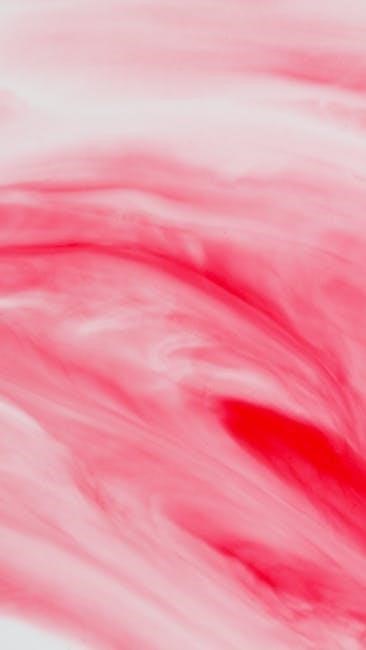
Mastering Atmosphere and Mood in Watercolours
Watercolour painting PDFs reveal how light, shadow, and colour create emotional depth. Techniques like glazing and soft edges help craft ethereal moods, guiding the viewer’s perception.
Using Tone and Contrast Effectively
Watercolour painting PDFs emphasize tone and contrast as vital for mood creation. By balancing light and dark values, artists guide the viewer’s eye, evoking emotional responses. Techniques like layering washes and strategic brushstrokes enhance depth, while high contrast adds drama. Soft gradations create subtlety, allowing for nuanced expressions. These methods, explored in detail in watercolour guides, help painters master visual storytelling and atmosphere in their work.
Creating Depth and Perspective
Watercolour painting PDFs highlight techniques to achieve depth and perspective, essential for immersive compositions. Layering distant elements with softer, cooler hues and bringing foregrounds forward with warmer, darker tones creates a sense of space. Atmospheric perspective softens faraway objects, while overlapping and size variation enhance dimensionality. Leading lines and linear perspective guide the viewer’s eye, building a dynamic visual journey. These methods, detailed in watercolour guides, help artists craft engaging, three-dimensional scenes that captivate and draw viewers into the painting.
Expressing Light and Shadow
Mastering light and shadow in watercolour painting PDFs is crucial for adding dimension and mood. Use transparent washes to suggest soft light and gradual transitions. Darker pigments and layered glazes create deep shadows, while white space or masking fluid retains highlights. Contrasting light and dark areas directs the viewer’s focus and defines forms. Techniques like wet-on-wet and drybrushing enhance texture, mimicking light’s play on surfaces. These methods, explored in detail, help artists convey dramatic or subtle lighting to evoke emotion and depth in their work.
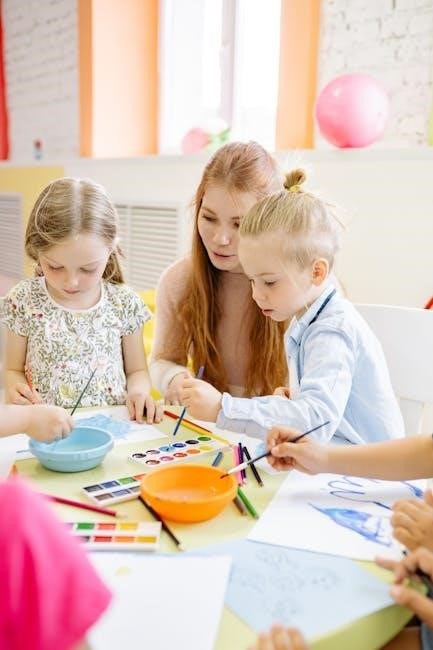
Still Life and Flower Painting
Still life and flower painting in watercolours bring vitality and beauty. These subjects allow artists to explore colour, texture, and composition, blending light and shadow for depth and expression.
Setting Up Your Still Life Composition
Setting up a still life composition involves careful planning and arrangement. Start by selecting objects that share a theme or texture, ensuring visual harmony. Arrange items at varying heights to create dynamic balance. Pay attention to lighting—natural light enhances shapes and shadows. Experiment with negative space to avoid clutter. Use a unifying background color or fabric to tie elements together. Sketch the setup beforehand to plan proportions and placement. Observe how light interacts with surfaces for realistic effects. This foundation ensures a compelling and cohesive piece.
Painting Flowers: Tips and Tricks
Painting flowers requires delicate touches and attention to detail. Start by selecting fresh, vibrant blooms for inspiration. Use reference images to capture shapes and colors accurately. For petals, apply wet-on-wet technique to blend soft edges. Layer glazes for depth and luminosity in flower centers. Avoid overloading brushes with paint; use light strokes for texture. Soften edges with clean water to create natural curves. Experiment with negative painting to define intricate details. Practice loose brushwork to convey movement and life in your floral compositions.
Landscape Painting in Watercolours
Landscape painting captures nature’s beauty through soft skies, distant mountains, and reflective water. Use wet-on-wet for blending and glazing for depth. Experiment with brushes and sponges for textures. Practice capturing light and atmosphere to evoke mood. Start with sketches, then build layers from background to foreground. Explore seasonal changes and weather effects to add variety. Mastering landscapes requires patience and observation of the natural world.
Sketching Landscapes
Sketching landscapes is the foundation of watercolour painting, allowing artists to plan composition and balance. Use graphite pencils or charcoal to outline shapes and forms.
Start with gesture drawing to capture movement and energy in natural scenes. Create thumbnail sketches to explore perspectives and lighting. Simplify complex elements into basic shapes and values. Pay attention to horizon lines, perspective, and proportion. This step ensures harmony and structure, guiding the painting process. Practice sketching outdoors to observe details and textures directly from nature.
Capturing Skies and Water
Capturing skies and water in watercolour requires subtlety and precision. Skies often set the mood, so use soft, layered washes to depict clouds and gradients. Wet-on-wet techniques create smooth transitions for atmospheric effects. For water, employ glazing to achieve depth and reflectivity. Use ripples and negative painting to suggest movement and light play. Blend colours lightly to maintain transparency, ensuring natural-looking reflections and textures. These elements add vibrancy and dimension to landscape paintings, making them feel alive and dynamic.
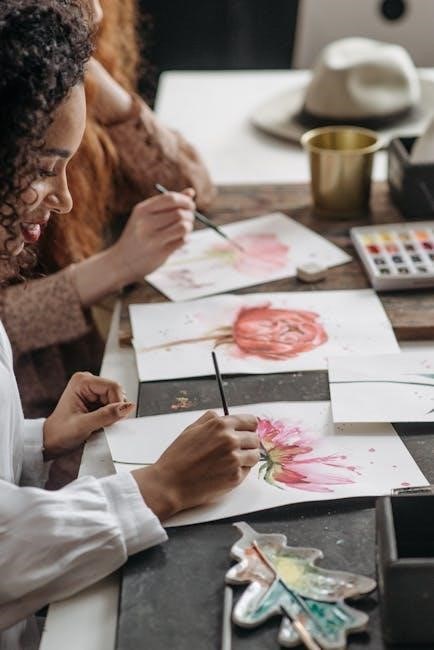
Adding Details and Texture
Adding details and texture enhances the realism and depth of your watercolour paintings. Use fine brushes to paint small elements like branches or facial features. Drybrush techniques create rough textures, perfect for trees or rocky surfaces. Glazing builds rich colours and adds depth to intricate details. Experiment with scratching tools to remove paint and reveal highlights. Balance detail with subtlety to maintain the ethereal quality of watercolours. Practice layering and blending to achieve lifelike textures that draw viewers into your artwork.
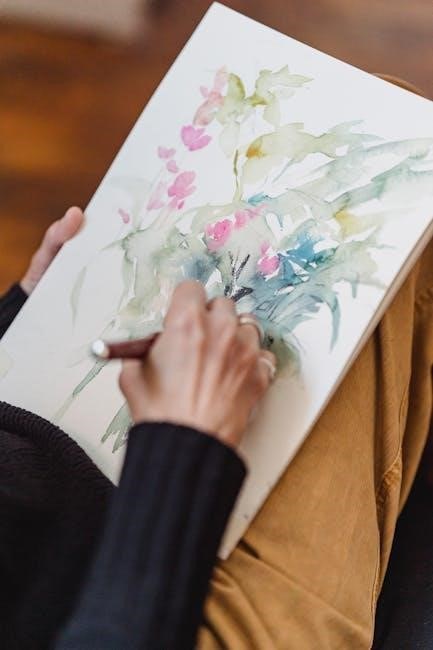
Modern Trends in Watercolour Painting
Contemporary watercolour artists explore bold colours, abstract expressions, and mixed media. Digital tools inspire new techniques, blending tradition with modernity. Social media platforms showcase these evolving trends globally.
Contemporary Styles and Techniques
Modern watercolour artists are embracing experimental approaches, blending traditional methods with innovative techniques. Abstract expressions, loose brushwork, and vibrant colour palettes are gaining popularity. Mixed media integration, such as combining watercolours with ink or collage, adds texture and depth. Digital tools also influence contemporary styles, enabling artists to plan and refine their work virtually. These trends reflect a dynamic evolution, pushing the boundaries of what watercolour painting can achieve. Artists today are redefining the medium, creating fresh and captivating visual languages.
Digital Tools and Their Impact
Digital tools have revolutionized watercolour painting, offering new ways to create and share art. Software like Procreate and Adobe Photoshop enable artists to mimic watercolour effects digitally, while apps provide tutorials and classes. Social media platforms showcase work globally, connecting artists and inspiring trends. Digital platforms also host watercolour painting PDF resources, making learning accessible. While traditional methods remain cherished, digital tools expand creative possibilities, fostering innovation and collaboration; They bridge the gap between physical and virtual art, enriching the watercolour community.
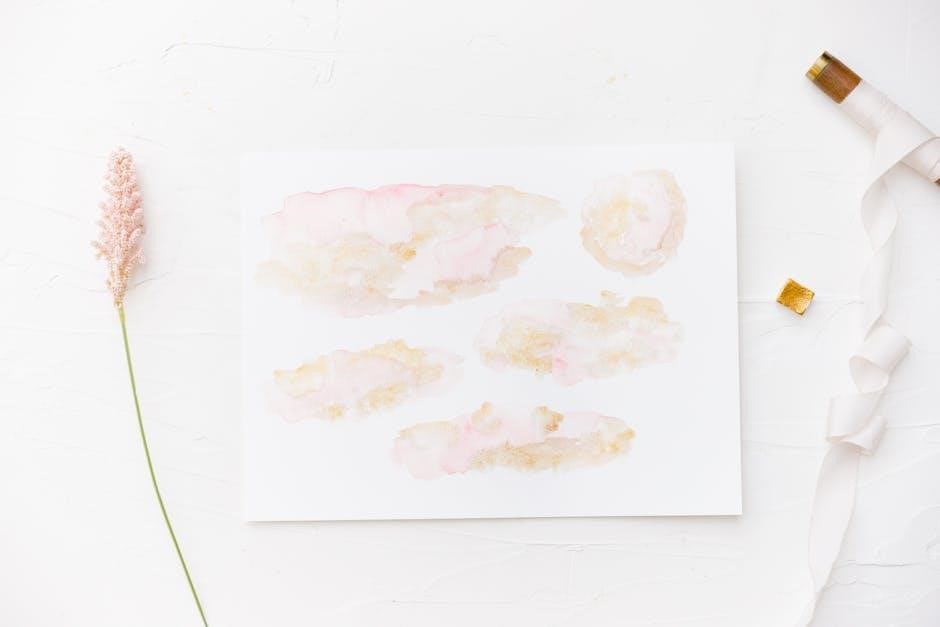
Lessons from Leading Watercolour Artists
Leading watercolour artists share insights and techniques, offering valuable lessons for refining your craft. Their expertise, available in watercolour painting PDF guides, enhances your artistic journey.
Charles Reid’s Approach to Watercolours
Charles Reid, a renowned watercolour artist, emphasizes direct and expressive painting. His approach focuses on capturing light, shadow, and form with minimal strokes. Reid advocates for simplifying subjects, using bold brushwork, and mastering colour harmony. His techniques, detailed in watercolour painting PDF guides, highlight the importance of observing life and translating it spontaneously onto paper. Reid’s methods encourage artists to embrace imperfection and focus on the essence of their subjects, creating vibrant, dynamic compositions;
- Direct painting with confidence and spontaneity.
- Mastering light and shadow for depth and mood.
- Simplifying forms to capture the essence of a subject.
Joseph Zbukvic’s Secrets to Mood and Atmosphere
Joseph Zbukvic is celebrated for his ability to evoke profound mood and atmosphere in watercolour. His mastery lies in capturing light and shadow, often using wet-on-wet techniques to blend colours seamlessly. By focusing on the interplay of light with his subjects, Zbukvic creates emotionally resonant paintings. His approach emphasizes the importance of observation and practice, encouraging artists to study natural light and its effects. This method, detailed in watercolour painting PDF guides, helps artists convey depth and feeling in their work effectively.
- Mastering light and shadow for emotional impact.
- Using wet-on-wet techniques for soft transitions.
- Observing and capturing natural light effects.
Mastering watercolour painting requires patience and practice. This guide provides a comprehensive roadmap for artists to refine their skills and explore creative possibilities.
Practicing and Improving Your Skills
Consistent practice is key to mastering watercolour painting. Set aside time daily to experiment with techniques like washes, blending, and colour mixing. Start with simple exercises, such as painting gestural sketches or studying colour harmony. Use reference images to practice capturing light, shadow, and textures. Reviewing your work regularly helps identify areas for improvement. Stay inspired by exploring new styles and techniques through watercolour painting PDF guides and online tutorials. Remember, every brushstroke brings you closer to refining your craft and achieving artistic excellence.
- Practice gestural painting to loosen your style.
- Study masterpieces to understand composition and technique.
- Experiment with different paper textures and brush types.
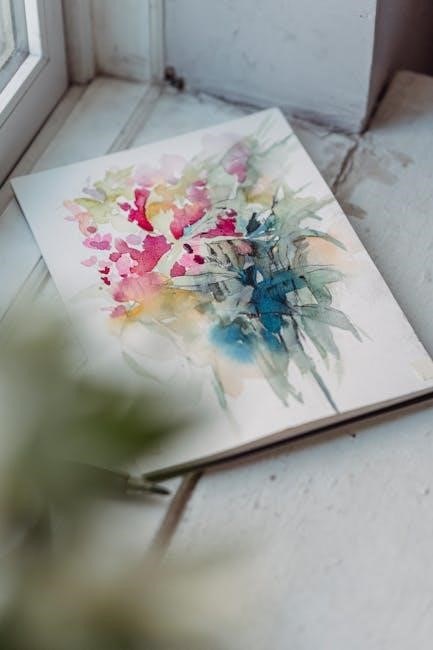
Exploring More Resources and Communities
Expand your watercolour journey by discovering a wealth of resources and communities. Watercolour painting PDF guides offer detailed tutorials, step-by-step exercises, and expert tips. Join online forums, social media groups, and art communities to connect with fellow artists, share your work, and gain feedback. Attend workshops, webinars, and classes to learn from experienced instructors. Explore blogs, YouTube channels, and art platforms for inspiration and new techniques. Engaging with these resources will help you grow as an artist and stay connected to the vibrant watercolour community.
- Join online forums for feedback and inspiration.
- Explore watercolour painting PDF guides for tutorials.
- Attend workshops to refine your skills.